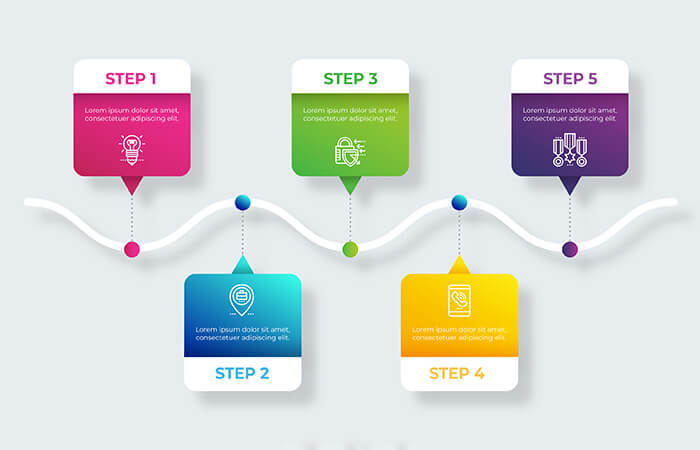Creative Content Marketing is an approach to attracting your business’ target audience by creating and distributing relevant content. It’s one of the most efficient strategies for increasing organic traffic. Therefore, it’s crucial to create a comprehensive content marketing checklist to develop smart strategies and track performance.
A sound content marketing checklist is one of the ways that a business can shape its brand identity, gain prospects’ interest and ensure content engagement. Likewise, it gives you the authority in your location, a sense of legitimacy, and builds trust between you and the people you wish to reach.
Content Marketing is currently trending globally, and it’s precisely what your small business needs in 2022. In this article, we’ll dive into:
- Complete Content Marketing Checklist for small businesses in 2022
- Best types of Content Marketing
- Content Marketing Processes
Content Marketing Checklist for Small Businesses in 2022
The best way to ensure that you successfully execute all required content marketing tasks is to follow a content marketing checklist. Below is a content marketing checklist to ensure that you’re taking full advantage of all the benefits of content marketing.
1. Understand the Concept of Content Marketing
The first thing in our content marketing checklist is to ensure that you have a vivid idea of what content marketing is about and why it’s essential for the success of your digital marketing campaign. Therefore, without further ado, let’s dive in.
Content marketing is mainly centered around five things:
- Defining your audience.
- Creating content to satisfy them.
- Building Search Engine optimized content that is rankable.
- Promoting content through your website or social media channels.
- Analyzing the performance of your content.
Also, content marketing is vital to your business because:
- It boosts SEO ( internal link)
- It increases brand awareness
- Greater ROI compared to other marketing strategies
- Best for online businesses
So, the next time you begin crafting content, you must understand and digest the basics above.
2. Know Your Target Audience

The first actionable step is to do market research and understand your audience. After your research, you should be able to answer questions like:
- What kind of content do they like?
- What questions or problems do they have?
- How can you solve their problems?
- What channels do they prefer to answer questions?
Answering these questions will frame the nature of your content, and you can then proceed to create a buyer persona.
3. Create a Content Marketing Strategy

Before deciding what content to create, it’s crucial to have a feasible strategy. Your strategy must answer questions like:
- What are your goals? Is it brand awareness, lead generation, more likes on social media, greater engagement, or something else?
- What tools do you use to create content (Microsoft Word, Hemingway editor, Grammarly)?
- How often do you wish to publish new content?
- What tools do you wish to use for research (Google Analytics, Ubersuggest, Semrush)?
- What are your monthly monetary budget and time allocation for content marketing activities?
- How do you measure your content engagement or campaign effectiveness?
- What type of content do you wish to create (text, audio, or video)?
Once you can satisfactorily answer the questions above, you can start creating optimal content.
Also Read: 9 Tips To Boost Your Business with Better Content Engagement Strategies
4. Find Topic Ideas

The next step is to find and know the process of finding topic ideas or keywords for your content. The right type of content is one that:
- Your audience wants to consume
- Can increase your search engine ranks
- Can generate more leads/sale conversion or email specific subscription
5. Create a Content Marketing Plan
Once the questions above have been answered and checks ticked, the next step is to create a detailed content marketing plan. Again, you can use Google Calendar, Excel, or Google Sheets. Some of the information to have in your project includes:
- When will each content be published, and on what channels?
- What title will you use?
- How long will your content be?
- What are your keywords?
- Who will write the content (if there’s a team)?
- How will the content be promoted?
- When will the content be analyzed and updated?
6. Create The Content
To do this, you have to have a clear understanding of:
- Pillar Pages?
- What content clusters are, and how to use them?
- Evergreen content and why it’s important?
- Techniques for creating linkable assets?
You should never sacrifice quality for quantity. Each content piece you create is an asset to your website and should be treated accordingly.
7. Optimize Content for Search Engines

Before publishing content, you have to ensure that it’s Search-engine-optimized. Search-engine-optimized content is friendly for both search engines and users.
Some essential checks to tick include:
- Optimize your past post titles to include your target keywords.
- Make sure your title is unique.
- Use short URLs and retains your target keyword
- Use only one H1 and title tags
- Create content that is easy to read and digest
8. Promote The Content

It isn’t an optional check on the list. However, a lack of proper content promotion waters down your efforts.
Your content promotion checklist should include:
- Post the content several times on your social media page(s).
- Connecting with websites mentioned in your content. Linking your website to others and letting them know.
- Distributing the content to your email subscribers (via newsletters).
- Promoting your content using paid advertising on various social media platforms.
- Promoting the content by adding internal links from other posts.
9. Learn To Use Content Marketing Tools

Tools are essential to successful content marketing. These tools will boost your keyword research and help to measure the effectiveness of your content marketing campaigns.
Some of the tools that can help you with content marketing are:
- Google Analytics – For monitoring the performance of your content.
- SEMRUSH – For topic and keyword research, content audits, content creation, etc.
- Google Search Console – For monitoring the Google rankings of your content
- Google Trends – For topic research
- Ahrefs – For finding topics, keyword ideas, content ideas, and competitor analysis.
- Google Keyword Tool – For keyword research
- Google Data Studio – For reporting and analysis
- Grammarly – For improving the grammar and spelling of your text content
- Hemingway Editor- To check readability and engagement levels.
10. Analyze and Monitor the Performance of Your Campaign
You cannot simply generate content and dump it on the internet, hoping that it will cause the expected results. You need to monitor the performance constantly. Some standard metrics to measure the performance of your campaigns include;
- Bounce Rate
- Email signups
- Number of leads/sales
- Amount of shares, likes, and comments
- Total Backlinks Count
Creating a spreadsheet and having all that information in one place will allow you to find out what works for your audience and how to audit your content marketing plan accordingly.
The Best Types of Content Marketing
Below are 10 of the most common types of Content Marketing that will boost your brand awareness, sales, and leads.
1. Blogs

Blogs are the most popular form of content marketing. Blog content has been used to build and monetize loyal followings. In addition, blog posts improve SEO and pass as a less expensive way to boost organic traffic.
Blogs work best when you focus on long-form content and SEO strategies.
Note: Remember to keep your content relevant to your product.
2. Infographics

The use of Infographics is an eye-catching way to present statistics. Infographics are helpful because informative content can quickly become tedious. Infographics help to keep audiences with short attention spans and can be deployed in the form of:
- Images
- Icons
- Data
- Text
- Graphs
- Diagrams
An infographic is a great plus for a blog post. It can increase engagement on social media and is inexpensive to create.
If others start making references to your infographics, you’ll also receive more backlinks and exposure.
3. Videos

Videos help you engage your target audience quickly. As platforms like YouTube and TikTok continue to grow, video marketing will soon become a necessity for content marketers. If you’re looking to harness the power of TikTok for your marketing efforts, you might want to consider using a reliable tiktok downloader to save and repurpose trending TikTok content.
Advantageously, video marketing presents opportunities for all kinds of businesses. Below are a few practical ways to promote your brand using videos:
- Creating How-to videos
- Interviewing experts in your industry in your videos
- Incorporating customer testimonials
- Showing behind-the-scene excerpts
- Answering customers’ questions
You don’t need an overly professional setup to create videos that generate leads. In fact, today’s customers’ value authenticity. Therefore, a behind-the-scenes excerpt will be an eye-opener for the customers to see the humans behind the brand. For maximum reach, remember to post your videos in multiple places, such as your website and social media platforms.
4. Webinars

73% of B2B companies say they generate the most high-quality leads from webinars.
Webinars are online seminars conducted over the internet. Through webinars, businesses can instruct, demonstrate and educate a segment of their target audience. Webinars are effective for B2B companies and are also used by B2C in some cases.
You can also increase your digital marketing strategy ROI by recording and replaying on-demand webinars for more fundamental topics.
5. Case Studies

They are an excellent trust builder for leads who want to learn more about your business and service quality. Case studies present a customer’s journey with the brand from start to finish.
Your case study should be like a story about your client and show your brand in a successful supporting role. Showcasing satisfied customers helps sales prospects believe that you can also deliver positive results for them.
6. E-Books

E-books are like blogs but more worded. They are a means of giving potential customers valuable information about your brand. They are commonly used as magnets to increase subscribers and identify quality leads. Your e-book should contain actionable tips to help your target audience generate their desired result.
7. GIFs and Memes
A GIF is an image file used to create animated images. In contrast, a meme is an image with culturally relevant text that can rapidly circulate on the internet.
Because of their ability to go viral, they instantly boost brand awareness and engagement on social media. GIFs and memes work particularly well among B2C companies. Sometimes, your customers just want to be entertained as opposed to long-form texts.
GIFs and memes are also easy and inexpensive to create. All you need is a creative mind. Always remember to define your brand’s tone and risk tolerance because viral content could easily stray off-brand.
The image above is an example of a funny meme
8. Testimonials & Reviews
Testimonials and reviews are the content generated from your audience. They give a short synopsis of why your company stands out.
Below is an example of a customer testimonial used as a marketing strategy.
Many companies create their commercial content from celebrity endorsements and reviews. However, smaller businesses can benefit from adding customer reviews to their website or emails.
9. Podcasts

Podcasts are an easily accessible content marketing type. They enable customers to get information while performing other tasks. For example, customers can listen to your podcasts while doing daily chores like driving, cooking, or walking.
Podcasts are designed for people on the go and are a great content marketing type for your business. Inviting experts to speak on your podcast helps build trust and sparks your audiences’ interest.
Below is a GIF showing the Spotify podcast charts
10. Whitepapers

Last but not least, whitepapers. These are not e-books but are often mistaken as such. Whitepapers are also lengthy but more densely packed with data and information.
Whitepapers are also quite detail-oriented. They break down data using charts and graphs. However, whitepapers are more intriguing when you craft them with appealing fonts and designs.
The above is suitable for your small business because they are relatively inexpensive compared to other digital marketing strategies.
Content Marketing Process
Creative Content Marketing seems simple on the surface, but in practice, many parts need to work in synergy for success.
There are a lot of different models that map out the content marketing process. These have been broken down into five stages.
1. Content Planning and Strategy
The first step includes everything involved in developing the overarching strategy for your content.
2. Understanding Your Audience
Who are you creating content for? What are their most significant wants, needs, and pain points?
These are some of the questions you need to ask yourself initially. To find your audience, you need to answer these questions:
- What problems does my company solve?
- Who are our current customers?
- Who is my competition?
- What sets us apart from the competition?
The answers to these questions will help you learn:
- What topics does your content need to cover?
- Who will read, watch or listen to the content?
- What is your competition doing, and how can you outpace them?
- What can you do to set your content apart?
Once you have this information, it’s time to establish your content’s core; what you do and what your audience cares about.
You can get information about what your audience cares about by running an audience survey, looking at your competitor’s content, or looking through social media.
3. Develop Buyer Personas
A buyer persona is a character description of your average customer. It should include the following:
- Age
- Location
- Occupation
- Income level
- Hobbies
- Education
- Challenges and goals
- Personality summary
- Values and fears
- Favorite blogs or news sources.
4. Set Measurable Goals
A common goal-setting framework is the ‘SMART’ system. This means setting goals that are:
- Specific
- Measurable
- Actionable
- Realistic, and
- Timely
5. Develop a Content Strategy
To do this, you need to answer three questions;
- What will you create?
- Why will you make it?
- How will you measure your success?
Once you answer the above questions, it’ll be the right time to perform Content Audits.
6. Conduct Content Audits
Performing content audits occasionally help you create more content that works, remove what doesn’t, and avoid duplicating efforts.
Some of the things to look out for when evaluating content includes;
- Pages that are getting traffic but aren’t converting
- How many shares are you getting on social media, and on what particular days?
- Content formats and subjects
- Content gaps
- Patterns
- Social media returns
7. Generate Ideas
Generating unique ideas is imperative to creating useful content pieces. You can brainstorm ideas in 2 ways:
- Solo Strategy – Where individual team members create content and campaign ideas independently.
- Group Brainstorming Sessions – Where multiple team members collaborate to find ideas.
8. Content Creation
It includes everything involved in creation processes and workflows. For instance, understanding keyword research is crucial for creating content that your audience wants. Therefore, your keyword research should achieve three goals:
- Help you understand what people want to read.
- Provide you with a better understanding of the keywords.
- Identify what you can rank on.
Some tools for quality keyword research include;
- Google Keyword Planner
- Ahrefs Keyword Explorer
- Serpstat
9. Content Publishing & Distribution
Includes everything involved in establishing and publishing schedules and cadences. As soon as you have a workflow and process for creating content, you can determine how often you need to publish content.
On the other hand, content distribution and promotion cover everything involved in promoting a piece of content. For example, you can do this through social media platforms, email marketing, etc.
10. Content Measurement
It covers everything involved in analyzing performance and extracting insights to refine your content strategy in the future. As a result, you can measure content through analytics tools, such as Google Analytics, Heap, Adobe Analytics, Kissmetrics, etc.
Conclusion
We hope this content marketing checklist for small businesses will be all you need to take your business to the next level. By following it, you’ll not only create content systematically but will also gain an edge over your competitors.
It all comes down to creating compelling content and presenting it effectively. The key is to put yourself in your customer’s shoes. The content you create should highlight pain points, purchase triggers, and problems that ultimately encourage them to buy from you.
Our team of expert content writers works with you to understand and uncover your company’s goals, target audience, and uniqueness that gives you an edge over the competition.
We then create content marketing strategies to engage your ideal customers. Through the use of multiple online mediums, we integrate industry insight, essential metrics, collaborative expertise, and best content practices to improve conversions and revenue for our clients.
All you need is a Discovery Call to remove all the guesswork from your content and create a memorable brand.


